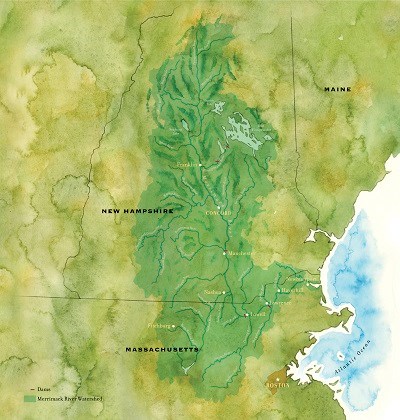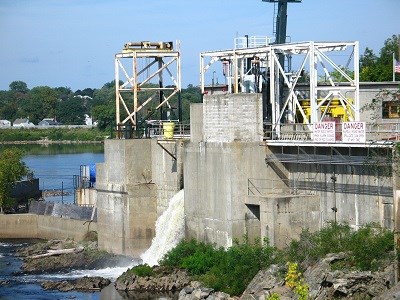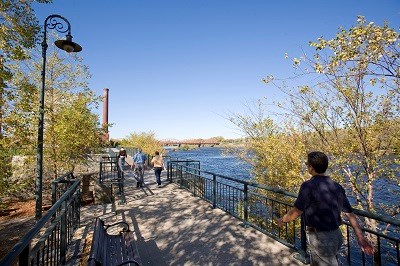
Jim Higgins IntroductionRivers powered New England’s early industrial cities. The Merrimack was one of the most important waterpower sources. It gave rise to Lowell's great textile mills. Yet for many along the Merrimack, the river provided more than just waterpower. The Early Merrimack: The Penacook ConfederacyPennacook Indians were this area's first recorded inhabitants. Each spring, tribes met at the Pawtucket Falls on the banks of the Merrimack to fish during the day and conduct business at night. Marriages and trade agreements between tribes strengthened the confederacy. At the close of the fish runs, tribes moved upriver to plant and harvest crops. In the 17th century, smallpox, war, and English settlement devastated the Pennacooks. Many died, while others moved north to Canada. By 1725, land once home to the Pennacooks was absorbed by the town of Chelmsford. A way of life was gone forever. The Dawn of IndustryThe colonists and their descendants used the river for fishing and for transportation. Merchants from Newburyport built the Pawtucket Canal (1796) to bring timber products around the Pawtucket Falls. Boston traders built the Middlesex Canal (1803) to ship goods to and from Boston. In 1814, a group of Boston merchants financed the country's first "integrated," water-powered textile mill. Located on the Charles River in Waltham, this mill housed all the machinery needed to turn raw cotton into finished cloth. In 1823, wishing to expand production, the Boston group began textile operations in East Chelmsford, using the 32-foot Pawtucket Falls. They founded ten textile companies in the town they renamed Lowell. For the next 30 years, the city led the nation in cotton textile production. 
Harnessing the RiverThe giant textile companies viewed water only as an element of production. The amount of water reaching a mill was artificially controlled to maximize output. Engineers controlled the water in the canals by building small, covered dams with gates that could be raised or lowered to release more or less water. Large dams on the river itself were another part of the system. Dams helped mill owners obtain a steady water supply by holding back water overnight. Lowell’s dam, built just above the falls, turned the river into an 18-mile-long mill pond. Other dams were built in Lawrence, Manchester, and elsewhere along the Merrimack. Control of the Merrimack’s sources in New Hampshire was also crucial to the water delivery system. The Lowell and Lawrence mills joined forces in the 1840s to buy rights to the waters of Lake Winnipesaukee, Newfound Lake, and Squam Lake. 
Environmental CostsThe growth of Lowell and other industrial cities on the Merrimack dramatically changed the river's ecosystem. One of the most noted changes was the disappearance of fish. Salmon, shad and Alewives were formerly abundant here...until the dam,...and the factories at Lowell, put an end to their migrations hitherward.... Perchance, after a few thousands of years, if the fishes will be patient, and pass their summers elsewhere...nature will have levelled...the Lowell factories, and the Grass-ground River [will] run clear again. Henry David Thoreau, A Week on the Concord and Merrimack Rivers, 1849. In addition to building dams, textile makers dumped wastes into the river. The canals of Lowell were especially loaded with trash and dyes, making the water unfit for drinking. Population growth also contributed to the pollution of the water supply. By the 1870s, human waste and run-off had contaminated Lowell’s wells, so the city began using filtered river water. Meanwhile, city sewage systems dumped wastes directly into the Merrimack. In the 1920s, 12 million gallons of Lowell sewage entered the river each day. Sometimes diseases traveled downstream from one river city to another. Corrective ActionsSince the 1970s, the river's health has been improving, in part due to activism and legislation. The Clean Water Act of 1972 mandated waste treatment plants and regulation of toxic discharges. Progress has sometimes been slow: Manchester, New Hampshire, stopped regularly dumping raw sewage only in 1992. The Anadromous Fish Conservation Act of 1965 led to a joint state-federal effort to restore migratory Merrimack fish such as salmon and shad. Salmon are taken from Lawrence to Nashua to spawn in a hatchery and are later released back into the river. Both wild and domestic salmon are stocked at various life-cycle stages. The goal is to get 3,000 salmon beyond Manchester. (The historic salmon population was 30,000). Shad are brought from Lawrence and released above Lowell to continue their journey. Fish ladders and elevators facilitate the migration of these fish. Other Merrimack fish include alewives, herring, and eels. 
A Vital ResourceThe Merrimack still supplies power via six hydroelectric dams on the river and almost 100 small power projects. Hydropower is generated in Lowell by a plant on the Northern Canal and by turbines in former mills. The Merrimack is also the second largest surface drinking water source in New England. It serves a total of 300,000 people through four water treatment plants. 
Jim Higgins The Future of the MerrimackThe river is still afflicted with pollution problems. Salt, grease, trash, and pesticides run off into the river from cities and suburbs alike. Activist groups allege that poor monitoring allows violation of toxics regulations. Recovering fish species must still be stocked. Aging treatment plants need updating. Riverside vegetation buffers are often lacking. And, as in many other waterways, mercury is found in the Merrimack. The most stubborn problem now is Combined Sewage Overflows (CSOs). Normally, sewage treatment plants treat both runoff and sewage. However, heavy rains can cause such an excess of water that some waste goes into the river untreated, periodically lowering water quality. Despite such problems, the river is fine for boating. Also, Lowell reopened its river beach in 1996, providing the state's only official river swimming east of Worcester. River fish are often suitable for eating, within state guidelines. |
Last updated: November 9, 2018
